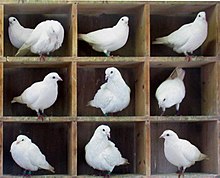 In mathematics, the pigeonhole principle states that if n items are put into m containers, with n > m, then at least one container must contain more than one item. Here there are n = 10 pigeons in m = 9 holes. Since 10 is greater than 9, the pigeonhole principle says that at least one hole has more than one pigeon. More...
In mathematics, the pigeonhole principle states that if n items are put into m containers, with n > m, then at least one container must contain more than one item. Here there are n = 10 pigeons in m = 9 holes. Since 10 is greater than 9, the pigeonhole principle says that at least one hole has more than one pigeon. More...
Solving Math problems can be interesting with online learning sessions. Students can take these sessions based on their learning requirements and most importantly, they can schedule these sessions by staying at their home. It saves their time and gives personalized attention to students. They can work with proficient subject experts and solve tough Math problems in a virtual environment. It has been observed that most students face difficulties while solving Math problems and to tackle this situation, students need to revise each Math chapter in a thorough manner. Moreover, they can solve online Math questions, as well. More...
Multiplication Principle states: If an event occurs in m ways and another event occurs independently in n ways, then the two events can occur in m × n ways.
Example of Multiplication Principle
A pizza corner sells pizza in 3 sizes with 3 different toppings. If Bob wants to pick one pizza with one topping, there is a possibility of 9 combinations as the total number of outcomes is equal to number of sizes of pizza × Number of different toppings. More...
The following 2 statements are logically equivalent:
Consider the following example:
There are 5 cat cards, 4 dog cards, and 1 rabbit card on the table. They belong to Tim or Sam. More...
A quadratic equation looks like this:
ax² + bx + c = 0 (where 'a' cannot be zero.)
Solving the equation means finding ‘x’ values that make the equation true. These ‘x’ values are called the roots of the quadratic.
Quadratic equations can have 0, 1 or two roots.
The quadratic formula is derived from the general quadratic equation (below) by completing the square. More...
Suppose you have 2 lines: l and k. If l and k are perpendicular to each other, then the slope of perpendicular line k is the negative reciprocal of the slope of line l, ie Slopek = -1/Slopel
The following shows you how to determine the slope of a line and the slope of its perpendicular line: More...
The slope m of the line through the points (x1, y1) and (x 2, y 2) is given by

With the dawn of the Internet, the birth of Internet slang, and the growing use of SMS, many of us are starting to forget the fundamental aspects of English punctuation. Would you like to write a great paper for one of your classes or submit a polished, impeccably-written proposal to your boss? If so, proper punctuation usage is a must. Consider the following rules to get started! More...
If you want to be understood, and if you want your ideas to spread, you need to use effective language. In the modern world of business and politics, imprecise language is used intentionally to avoid taking a position and offending various demographics. No wonder it’s hard to make sense of anything!
This is hardly a recent problem, and George Orwell, a famous English writer, wrote in his 1946 essay, Politics and the English Language, that there are 5 rules for effective writing: More...
A force is a push or pull upon an object resulting from the object's interaction with another object. Whenever there is an interaction between two objects, there is a force upon each of the objects. When the interaction ceases, the two objects no longer experience the force. Forces only exist as a result of an interaction.
All forces (interactions) between objects can be placed into two broad categories: More...